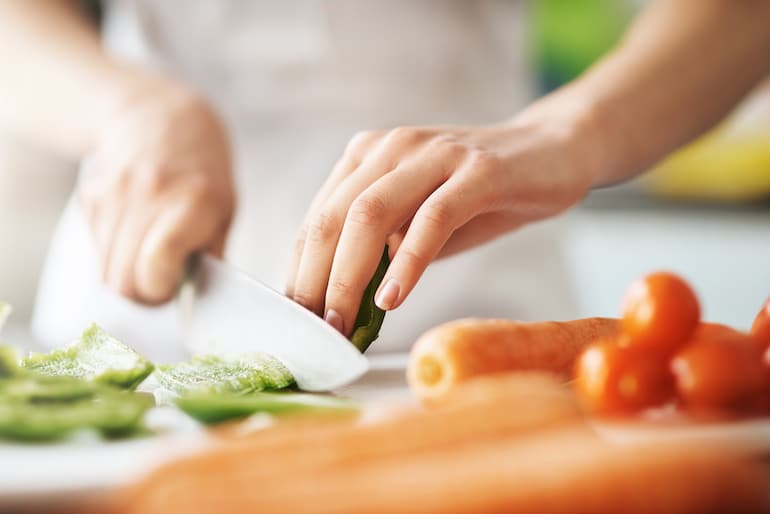How to Sharpen Kitchen Knives and Other Knife Care Basics
I love to cook but know next to nothing about kitchen knives. So, I enlisted the help of celebrity chef Mychael Chang to teach me how to shop for, sharpen, and care for kitchen knives.
what to look for in Kitchen Knives
First, is it really worth it to invest in expensive kitchen knives? In fact, how expensive your knives are is less important than how well you maintain them. But, there is a difference in performance, fit, and longevity when it comes to pricier knives.
“The problem with cheaper knives is usually the blade isn’t going to stay as sharp as some of the better quality knives,” Mychael shares. The blade itself may also be thinner with more expensive knives for greater precision. Also, there’s an ergonomic difference. “I notice a big difference in the fit and feel of the handle.”
Whatever your price point, Mychael recommends shopping with a trusted brand, reading reviews, and looking for forged knives.
Forged vs. Stamped
Knives come in one of two varieties. Forged knives refer to those made from a single piece of steel. By contrast, stamped knives have two or more pieces that are forged together.
“Personally, I always like the forged knives,” Mychael says. Stamped knives run the risk of developing a loose handle over time whereas a nice, well-maintained forged knife will last a lifetime.
Types of Kitchen Knives
These are the basic types of kitchen knives Mychael recommends investing in to cover all your cutting needs:
- Chef knife: used for most everyday cutting and chopping
- 10-inch: useful for cutting into dense or wide materials
- Slicing knife: for serving cooked meats and fish
- Serrated knife: to cut through bread or tomatoes
- Boning knife: for deboning and filleting

How To Care for Kitchen Knives
Here are a few basic rules to help your knives stay sharp and last forever:
Always Hand Wash Your Knives
“Never put your knives in a dishwasher,” Mychael warns. “Never.” Instead, wash your knives by hand, dry them off immediately, and put them away. “I see a lot of people washing knives and leaving them point-down in a drying rack but it’s going to ruin the tip of your knife.”
Never Share Your Knives
“It sounds funny but I never share my knives with other people,” Mychael explains. The reason? Knives actually adapt to our personal grip and movement over time. “The way that you hold a knife impacts how the knife will dull over time,” she elaborates. To keep a clean line, it’s best to use your own tools.
Sharpen Knives Often
“I can’t emphasize how important it is to have a sharp knife,” Mychael says. Some people may shy from sharpening their knives for fear of cutting themselves. However, you actually run a much greater risk of cutting yourself with a dull kitchen knife. “The sharper your knife, the less pressure you need to apply,” she affirms.
How to Sharpen Kitchen Knives
First, you’ll need supplies. Mychael works with a sharpening stone and honing steel. Here’s how to sharpen kitchen knives using these tools:
1. Select and secure a sharpening stone
There are two main types of sharpening stones. One is made with crushed diamonds on the surface and the other is made of stone. With either type, you’ll want to first ensure that your sharpening stone is on a secure surface. (Mychael uses rubber non-slip pads beneath hers for optimal safety.)
2. Wet the surface
Next, you’ll wet the surface of your sharpening stone. Diamond sharpening tools can work with a splash of water while a more classic whetstone requires special honing mineral oil. (This is preferable to olive oil or other food oils, as they will eventually spoil in the porous stone material.)
3. Pull even strokes along the edges
Hold the knife at a twenty-degree angle from the stone and pull it all the way across with even pressure. Apply steady force from the base of the blade to the very tip. Repeat eight to ten times on each side of the blade. If you find that one side is sharper than the other because of your personal grip and cutting habits, do extra strokes on the dull side until it’s even.
4. Finish with a honing steel
The honing steel doesn’t sharpen your blade, but it does help to refine and seal the edges. (Think of it a little like the smoothing side of a nail file.) Alternatively, some sharpening stones have a side with a finer grain that can also be used to hone the edge of your blade in place of a honing steel.
To use a honing steel, grasp it firmly in your non-dominant hand. Make sure your fingers are safely beneath the safety handlebar. Just like before, you will pull the edge of the blade along the steel at a twenty-degree angle. Using even pressure, move the entire blade against the steel from base to tip on both sides. Repeat another eight to ten times.
How often should you sharpen knives?
How often you use your knives will determine how often you need to sharpen them. As a professional chef, Mychael typically sharpens hers once a week. Regular home cooks can shoot for once a month as a good goal to start with.
Final Tip
If sharpening kitchen knives still intimidates you, there are professional knife sharpeners you can enlist the help of. Some come to your home for a minimum order while others are available at kitchen supply stores or farmer’s markets.
For more practical kitchen tips, follow chef Mychael Chang on Instagram. You can also check out her delicious recipes for avocado gazpacho and this easy chicken paillard recipe.
The post How to Sharpen Kitchen Knives and Other Knife Care Basics appeared first on HUM Nutrition Blog.
Comments
Post a Comment